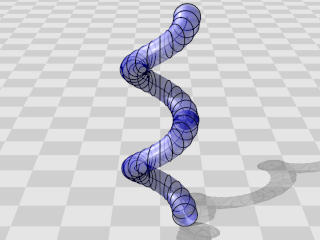 | ||
In geometry, a spring is a surface in the shape of a coiled tube, generated by sweeping a circle about the path of a helix.
Contents
Definition
A spring wrapped around the z-axis can be defined parametrically by:
where
The implicit function in Cartesian coordinates for a spring wrapped around the z-axis, with
The interior volume of the spiral is given by
Other definitions
Note that the previous definition uses a vertical circular cross section. This is not entirely accurate as the tube becomes increasingly distorted as the Torsion increases (ratio of the speed
An alternative would be to have a circular cross section in the plane perpendicular to the helix curve. This would be closer to the shape of a physical spring. The mathematics would be much more complicated.
The torus can be viewed as a special case of the spring obtained when the helix degenerates to a circle.
